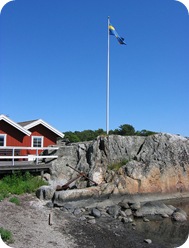Posts Tagged ‘swedish’
Day 3/30: 5 quirks of the Swedish language that make it awesome.
 Swedish, spoken by some 10 million people in Sweden and Finland, will probably never make it to the list of the most studied languages in the world. It might be because of its limited usefulness outside of Scandinavia, or because of the common belief that all Swedes speak English anyway – or, possibly, both – but, in any case, Swedish doesn’t seem to get much attention even among language passionates.
Swedish, spoken by some 10 million people in Sweden and Finland, will probably never make it to the list of the most studied languages in the world. It might be because of its limited usefulness outside of Scandinavia, or because of the common belief that all Swedes speak English anyway – or, possibly, both – but, in any case, Swedish doesn’t seem to get much attention even among language passionates.
But Swedish isn’t boring. Like any other language, it has a few adorable quirks and idiosyncracies that make it unique… Or annoying and a pain to learn, depending on your perspective!
- Definite forms of nouns are created not with an article appearing in front of the noun, like in many European languages including English, but by attaching a suffix to the end of the noun. The indefinite article, on the other hand, behaves just like in English.
- For example: en katt – a cat, katten – the cat; ett bord – a table, bordet – the table
- That’s kind of like saying catthe or tablethe ;)
- This kind of postfixed definite articles is found in other Scandinavian languages as well – which is not surprising, since they’re very closely related –
- but also in Bulgarian, Macedonian, Romanian, Albanian and Basque, which pretty much is.
- The so-called sje-sound is found exclusively in Swedish. No other language in the world seems to have it! It appears in such words as sjö (lake) or stjärna (star).
- It’s a voiceless fricative, transcribed as ɧ
- but its place of articulation isn’t easy to pinpoint, as it differs across dialects. It’s been described as velar and postalveolar, palatal-velar, palato-alveolar-velar, etc…
- Yes, it’s as hard to pronounce correctly as it seems.
- There’s a sample on Wikipedia you can listen to.
- It’s a voiceless fricative, transcribed as ɧ
- Swedish has quite a lot of vowels – some 17-18, depending on which of the many dialects you’re looking at. There are 9 basic vowels, but as they can come in either long or short forms, the number doubles easily.
- Vowel length isn’t something you can ignore if you want to speak comprehensible Swedish.
- You don’t want to confuse glass (ice-cream, short a) with glas (glass, long a), after all.
- Vowel length isn’t something you can ignore if you want to speak comprehensible Swedish.
- Just like Chinese, Swedish has tones.
- Kind of.
- Well, not really – it just has something called pitch accent.
- There are many pairs of words differentiated only by tone or stress.
- In those word pairs, the stressed syllables get either the acute or grave accent.
- For example: anden (the duck, acute accent), anden (the spirit, grave accent).
- Swedish learners usually have quite a hard time wrapping their head around this concept
- but, fortunately, unlike in Chinese, you can speak comprehensible Swedish without this advanced skill.
- Not all Swedish dialects have pitch accent; the one spoken in Finland, for example, doesn’t.
- Finally, there seems to be no limit to amazingly long compound words.
- Nagellacksborttagningsmedel, anyone?
- That’s nail polish remover.
- You’re probably not impressed if you have at least a fleeting familiarity with German, which offers endless possibilities for building long words as well. Well, Swedish and German are closely related, so it’s no surprise. Germanic languages and long words do seem to go together!